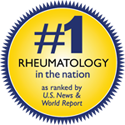Rheumatoid Arthritis
Rheumatoid arthritis (RA, rheumatoid disease) is an autoimmune disorder that can affect many joints, organs, and the body as a whole. Common complaints with RA are joint pain (joints feeling warm or tender), stiffness throughout the day, and a general feeling of sickness and fatigue. RA can make it difficult to perform routine activities, and fulfill social roles and obligations.
Learn more about Rheumatoid Arthritis
Psoriatic Arthritis
Psoriatic Arthritis is also an autoimmune disease that can present in people who have the inflammatory skin condition psoriasis. Like RA, this is disease can attack and damage joints, effecting a patients quality of life. Unfortunately, psoriatic arthritis is not well recognized in the general medical community, resulting in irreversible joint damage occurring in many patients before they are diagnosed. However, outcomes are improving for those with psoriatic arthritis because of newer therapies and treatment plans.
Learn more about Psoriatic Arthritis
Ankylosing Spondylitis and Spondyloarthropathies
Ankylosing spondylitis (AS) and other related spondyloarthropathies also fall into the category of autoimmune diseases. AS and other spondyloarthropathies affect the spine and lead to limited mobility of the back, pelvis, and hips. These conditions can also affect other joints on the body. Unfortunately, it can take a long time before people with this condition are diagnosed, sometimes diagnosis does not occur until there has already been damage to the joints, or joint fusions. New developments have identified promising pathways that are opening up different treatment possibilities for this condition.
Learn more about Ankylosing Spondylitis and Spondyloarthropathies
Osteoarthritis
Osteoarthritis (OA) is the most common form of arthritis, affecting nearly 30 million adults nationwide. OA is an irreversible disease that causes deterioration of the joints. Doctors usually describe OA as “wear and tear” arthritis. A common complaint from patients is pain in weight-bearing joints such as the hips, knees, and spine. OA can also involve joints in the fingers. Prior injuries and repetitive movement contribute to OA along with age.
Learn more about Osteoarthritis
Gout
Gout is a form of arthritis that causes pain and discomfort in the joints it’s affecting. Gout presents when there is a strong inflammatory response, which occurs when there are high levels of uric acid in the blood. A typical gout attack produces a sudden onset of severe pain, swelling, warmth, and redness of a joint. The clinical presentation of acute gouty arthritis is not subtle with very few mimics other than a bacterial infection.
Osteoporosis
Osteoporosis is a disease characterized by abnormalities in the amount and arrangement of bone tissue that leads to impaired skeletal strength and a susceptibility to fractures. The World Health Organization has proposed a clinical definition of osteoporosis based on data that links low bone mass with increased fracture risk.
The clinical concern of low bone mass is fracture. When a fracture occurs, there is a result of pain and immobility. Multiple vertebral fractures result in irreversible spinal deformity and chronic pain syndromes.
Osteoporosis is most common in post-menopausal women, while not as common, it can also occur in males as they age.

